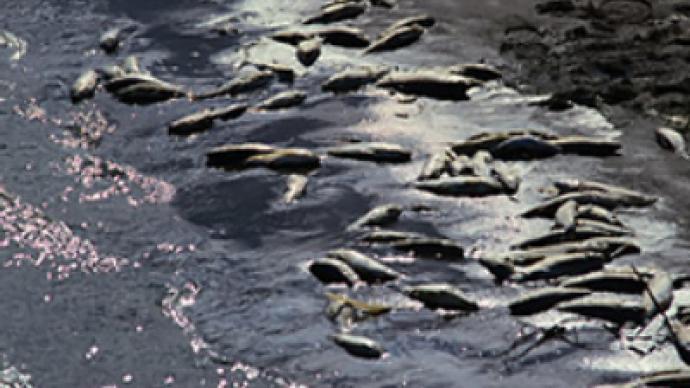Italy’s toxic ships: a crime of global proportions

Monsters of iron and steel with their bellies full of radioactive waste have been sitting at the bottom of the Mediterranean Sea for years.
A mafia turncoat recently made this revelation, confirming what Italian environmentalists have been claiming for the past two decades. Francesco Fonti, a former member of one of Italy’s deadliest and most far-reaching international crime syndicates, the ‘Ndrangheta, recently gave shocking testimony attesting to what a few Italians have known for years – that the Mediterranean contains many sunken merchant ships carrying radioactive and poisonous substances.
In his testimony to police Fonti said he was personally involved in the sinking of three ships containing radioactive waste in the Calabria region, and knows of at least 30 other vessels that were sunk in the sea over the last 20 years, one of which is located just off the coast of Tuscany.
According to Fonti, the vessels contained toxic wastes from pharmaceutical companies that paid members of the ‘Ndrangheta mafia between 1.5 and 15 million euros per ship to deliberately sink them.
On September 12, Italian authorities discovered one of the ships some 17 miles off the coast, near the town of Cetraro in Calabria. Days later, regional authorities sent robotic divers to about 1,000 meters below sea level to investigate the presence of radioactive or toxic waste. The robots revealed some 120 sealed containers and two human skulls inside the ship.
The turncoat’s testimony and the initial search effort was enough to sound environmental and health alarms across Italy, especially in the Calabria region where Fonti says most of the vessels were deliberately sunk. Regional officials in Calabria are now calling on officials from the Italian State to take immediate action to verify the contents of the containers and investigate further into the other 40 toxic ships that are said to line the Mediterranean seabed. Italy’s WWF recently joined these calls for action.
“Calabria is the perfect place to sink the ships because the seabed becomes really deep, very quickly. Plus it is the home of an international crime syndicate that is only concerned with profits and thus willing, for money, to destroy its own territory and the places in which its own members live. This is the most disgusting part about it for myself, as a Calabrian”, says Nuccio Barillà from Italy’s Environment League, the Legambiente.
Barillà points out, however, that the mafia is not only to blame, being just one of the many actors involved in the global trafficking of toxic waste and its illegal disposal. “The mafia fills a void and is willing to satisfy demand; but there is a whole world out there that wants to quickly and cheaply get rid of toxic waste at the expense of real people and the environment”, he adds.
For decades the Legambiente has been pursuing reports and police investigations into the dumping of ships laden with toxic waste.
“We have been investigating the presence of these so-called toxic ships in the Mediterranean for over 15 years, and what we’ve found out is that this is not only a national problem, but one of international proportions. The illegal dumping of toxic waste in the Mediterranean, and the world’s seas in general, is a global criminal act that involves very powerful, high profile figures and companies, not only from the West but also from Japan, Russia and many other countries. The mafia is not the only actor; there are also well-known politicians and corporate chiefs from around the world involved”, Barillà explains.
The likelihood that scores of toxic ships have been sunk in the Mediterranean is not new to Italy. In the 1990s, Italian prosecutors launched a series of investigations into sunken ships carrying toxic waste off the coasts of Italy, Greece, Malta and Libya. These investigations, however, were ended either due to a lack of evidence or a lack of support from the Italian State.
“Since the 1990s, scores of investigations have been opened by prosecutors across the country, but for some reason or another the cases were never fully investigated. Since 1991 we’ve been mapping the locations of sunken ships that may contain toxic waste. We know, and prosecutors know, where these suspected shipwrecks are, but no one, including the State, has ever gone underwater to reveal their contents. But this time the State has to take action”, Barillà said.
“We not only have the locations of suspected toxic ships, but we have a list of companies that can be called upon to safely pull these containers out of the sea. All the State has to do is ask. It’s been some 20 days since we produced proof of the ship and containers Fonti was talking about, which was dumped off Cetraro, and still nothing has been done”.
Politicians had to have known about the toxic ships being dumped, Barillà says: “It takes approximately 10 hours for ships that big to sink. It’s impossible that the port authority or the coast guard never witnessed or reported anything. They were likely paid off to turn a blind eye.”
What seems as the Italian State’s dilatory approach to the situation has enraged regional governments and local populations. Calabrian mayors have threatened to organize protests if the government fails to intervene and take action soon.
“We want to know if there is toxic waste. We cannot live with this terror,” says Aurelio Garritano, deputy mayor of Longobardi.
Local citizens are also making desperate calls for government action. “We want to be sure that the fish we buy from local markets doesn’t have toxic substances, that the tap water we drink isn’t polluted, that the air we breathe doesn’t have traces of radioactive dust and that bathing in the sea doesn’t pose a risk”, says Maria, a young mother of three young children who lives just 10 kilometers away from the town of Cetraro.
Scientific tests and satellite images carried out in the region reveal high levels of toxins and radioactive substances in areas along the Oliva River, located near the seaside town of Cetraro. Doctors and politicians have recently noted a sharp increase in the incidence of tumors and other pollution-related diseases among people living in these areas.
Bruno Giornado, the public prosecutor in the nearby town of Paola, recently told Italian media that this rise in tumors may be caused by the toxic contents of a ship that was sunk near the mouth of the Oliva River back in the 1990s.
Marco, a teenager who lives just 20 kilometers from Cetraro, hopes State officials act soon, not only to find out how many ships there are and what’s in them, but also to crack down on the local mafia.
“Everyone knows about the mafia, but we never talk about it here. Now with the news that these toxic ships may cause irreversible damage to our coast and land, and even kill people, Calabrians might start to speak out. It’s different when the mafia’s reach touches you personally. If they poison the land and they automatically poison the people, the people will start to fight back. The State, too, can no longer remain silent, especially because there are so many of us facing a death sentence.”
For over twenty years these toxic ships have laid silent at the bottom of the Mediterranean, threatening both sea and land. After years of investigations, it’s time that this inconvenient truth be brought to the surface, Barillà remarks.
“We won’t know the real effects of these so-called toxic ships for at least another twenty years, but by then it could be too late.”
Brenda Dionisi for RT












